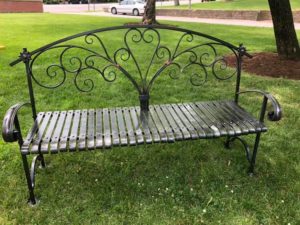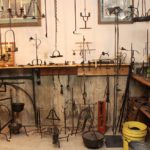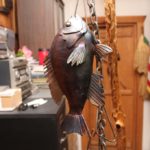2020 Traditional Arts Apprenticeship Program: Bob Alexander & Matt Dickson
It is with great pleasure that we roll out profiles of the 2020 Traditional Arts Apprenticeship Program (TAAP) teams of master artists and apprentices. Our regular Show Me Folk blog readers should recognize both members of this team from posts in 2019. [Be sure to click on hyperlinks for more of the story.]
Bob Alexander & Matt Dickson, Blacksmithing

TAAP apprentice Matt Dickson (left) and master blacksmith Bob Alexander pose on a bench outside Alexander’s Scrub Oak Forge during a site visit in early March 2020. They are displaying hand-forged lamps and chandeliers. Photo credit: Deborah A. Bailey
Robert (Bob) Alexander (DeSoto, Mo.) is a three-time TAAP master artist. Just last year, he taught apprentice Lisa Thompson, of Ste. Genevieve. And, in 2015, Mr. Alexander taught apprentice Mark Clifford, of Bonne Terre. In both previous apprenticeships, the intended (and achieved) outcome was for Thompson and Clifford to produce signs for their blacksmith businesses. This year, Alexander had a different apprentice, and their lesson plan included different goals and end products.
Readers here should also recognize Matt Dickson of Pevely, who had a successful apprenticeship in 2019 with master blacksmith Pat McCarty of Washington Forge in Washington, Mo. Dickson told Mo Folk Arts staff that he “learned an important advanced skill from [McCarty]–traditional joinery (mortise and tenon).” In that project Dickson made a beautiful garden bench, which required not only the skills he brought to the apprenticeship but new ones he learned from McCarty.

In a 2019 apprenticeship, Matt Dickson made this garden bench under the guidance of master blacksmith Pat McCarty. Photo credit: Lisa L. Higgins



